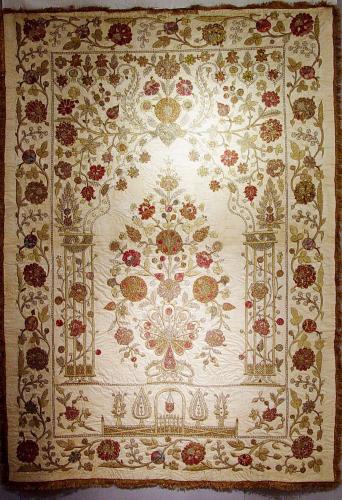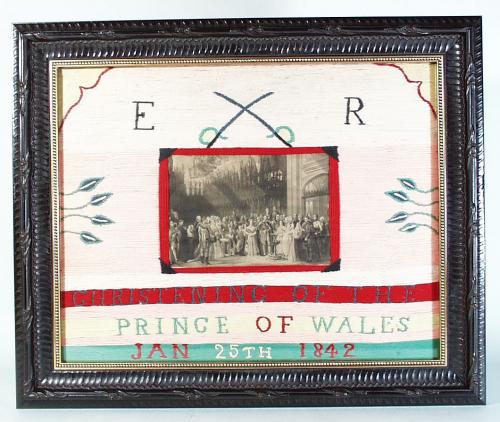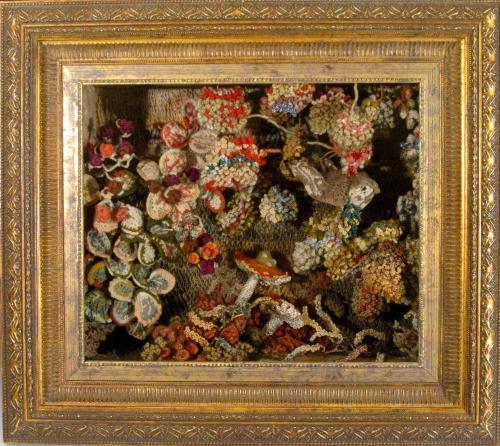

This object is eligible for a Certificate of BADA Provenance
The BADA Standard
- Since 1918, BADA has been the leading association for the antiques and fine art trade
- Members are elected for their knowledge, integrity and quality of stock
- Our clients are protected by BADA’s code of conduct
- Our dealers’ membership is reviewed and renewed annually
- Bada.org is a non-profit site: clients deal directly with members and they pay no hidden fees
Large Sailor's Woolwork depicting the Troopship HMS Jumna and The Battle Flags of the 82nd Regiment of Foot & The 40th Regiment of Foot, Motto of Fortieth Brigade.
Late 19th Century
Dimensions: 33 inches high x 35 inches wide
A remarkable large woolwork centered with a roundel of HMS Jumna at sea on a chevron sea. The motto at the top (Foutieth Brigade) refers the motto of the 40th Regiment which was "The Fighting Fortieth".
To either side are the Regimental Battle flags of two regiments- The 82nd and 40th which in 1881 were amalgamated to form the South Lancashire Regiment, (The Prince of Wales' Volunteers). It was deployed to Aden in 1884 and returned to the United Kingdom in 1886, where it remained until 1899.
The wool is most unusual with beautiful imagery. To the right, a soldier is on guard with a fort wall created with bamboo with a roaring lion outside. To the left is a large building and an image of a mason.
Reference:
Under the Childers Reforms, the two regiments amalgamated to form the Prince of Wales' Volunteers (South Lancashire Regiment) in 1881, The 40th became the 1st Battalion and the 82nd became the 2nd Battalion. The new regiment was deployed to Aden in 1884 and returned to the United Kingdom in 1886, where it remained until 1899.
This wool was probably created reflecting the transport to South Africa where the regiment was involved in the Second Boer War.
The 82nd Regiment of Foot was an infantry regiment of the British Army, raised in 1793. Under the Childers Reforms it amalgamated with the 40th (the 2nd Somersetshire) Regiment of Foot to form the Prince of Wales's Volunteers (South Lancashire Regiment) in 1881.
The 40th Regiment of Foot was an infantry regiment of the British Army, raised in 1717 in Annapolis Royal, Nova Scotia. The regiment played parts in many operations in Nova Scotia in the 18th century and played a part in Boston and New York during the Revolutionary War.
The regiment landed in Boston for service in the American Revolutionary War in June 1775. It was evacuated from Boston in March 1776 and went to Halifax from where a detachment was sent to Georgia to gather rice for the army in June 1776.
It saw action at the Battle of Long Island in August 1776, the Battle of Fort Washington in November 1776 and the Battle of Princeton in January 1777. It was in combat again at the Battle of Brandywine in September 1777 and the Battle of Germantown in October 1777.
In November 1778 the regiment embarked for Barbados and took part in the Battle of St. Lucia in December 1778. The regiment was then based in Antigua until June 1781 when it returned to Staten Island and then took part in the Battle of Groton Heights in September 1781: Major William Montgomery, commanding the regiment was killed in the assault.
In August 1782, the regiment took a county title as the 40th (the 2nd Somersetshire) Regiment of Foot. The regiment embarked for home in November 1783.
Battle honours:
Egypt, Montevideo, Roliça, Vimiero, Talavera, Badajoz, Salamanca, Vittoria, Pyrenees, Nivelle, Orthes, Peninsula, Toulouse, Waterloo, Candahar (1842), Ghuznee (1842), Cabool (1842), Maharajpore, New Zealand
HMS Jumna was one of five iron-hulled vessels of the Euphrates class. All five were built to a design of 360 ft overall length by about 49 ft breadth, although Malabar was very slightly smaller than the rest of the class. They had a single screw, a speed of 14 knots, one funnel, a barque-rig sail plan, three 4-pounder guns, and a white painted hull.
Her bow was a "ram bow" which projected forward below the waterline. She was commissioned jointly by the British Admiralty and the Indian government. She spent most of her active career conveying British troops to and from the Indian subcontinent.
In 1873 her Maudslay, Sons and Field 3-cylinder single-expansion steam engine was modified at Portsmouth by the replacement of one low-pressure cylinder with a smaller, high-pressure one, giving her a more efficient compound-expansion engine, albeit with less power and a new top speed of 13 knots
The BADA Standard
- Since 1918, BADA has been the leading association for the antiques and fine art trade
- Members are elected for their knowledge, integrity and quality of stock
- Our clients are protected by BADA’s code of conduct
- Our dealers’ membership is reviewed and renewed annually
- Bada.org is a non-profit site: clients deal directly with members and they pay no hidden fees




